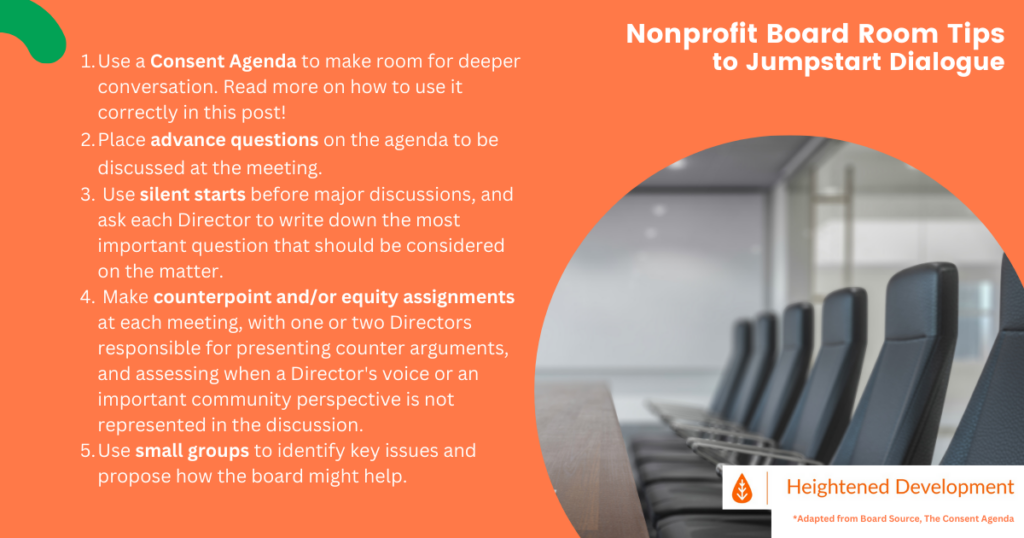Creating time in the board room for important conversation is key to a board practicing its duties and to board member engagement.
Nonprofit board members are more engaged and better able to fulfill their fiduciary duties when there is time during board meetings to ask questions, debate, strategize and problem-solve. The consent agenda is one tool that frees up time for this important work, so it is important to know what it is and the right way to use it.
What is the Consent Agenda and How Does It Work?
A consent agenda is a tool for streamlining meetings by allowing the board to quickly and efficiently approve routine items that don’t require discussion, discussion, freeing up time for more meaningful conversations. This important tool allows the board to ensure that it gets to the most important topics, leaving room to debate and strategize. Leading with Intent suggests that among the three important roles they identify for nonprofit boards (setting direction and strategy, providing oversight, and ensuring resources), setting direction and strategy is the most important one. They assert that this defines the organization’s purpose and direction around which all other activities and work sit. They assert that high-functioning organizations have boards that spend intentional time here.
A consent agenda should be composed of items that require no action other than approval, such as minutes from past meetings, informational materials, updates from committees, and occasionally financial materials. Sometimes the executive director/CEO’s report or board chair’s report is also lumped into the consent agenda. The key is that things placed in the consent agenda should be items where discussion and dialogue are not needed; essentially, they are information only, to keep everyone up to speed. Additionally, a clear process for how to use it is important so that you don’t discourage board engagement rather than encourage it, which is the point of implementing it in the first place.
Strategizing and Drafting the Agenda
The strategy around the consent agenda can be a key way to develop the board chair and paid executive leadership. Instead of just passing the same agenda back and forth via email to each other for the other to give a thumbs up, the conversation can be a deeper conversation that supports the executive director. The executive director and board chair can talk about things like:
- What do we really need the board to weigh in or wrestle with this month?
- What committee has been doing some especially meaningful work that needs further discussion (for board member engagement, board member oversight, or board understanding)?
- Where do have risks as an organization we haven’t talked through recently?
- Where is the executive director struggling with how to leverage resources to implement the right strategy?
After this deeper conversation, it becomes obvious which reports can go into the consent agenda. Minutes from the prior meeting nearly always can, as can many committee reports. I often see nonprofits include their financials in the consent agenda, but advise this only in your board meets monthly or much more frequently than quarterly. Remember that financial oversight is a clear fiduciary duty and if there is not time spent analyzing and discussing this at least quarterly, especially when many board members struggle to read a spreadsheet, this could be dangerous.
After engaging in this important dialogue, the board chair can finalize the agenda, making it clear on the agenda, which must be sent in advance, which items will be considered part of the consent agenda, and which will not.
Facilitating a Smooth Consent Agenda Process
A clear process for the consent agenda, which is followed, allows compliance with your bylaws, oversight responsibilities, and ensures that you don’t inhibit softer voices in the board room or discourage board members from asking questions. Your process should include these seven steps: create the agenda, distribute materials in advance, read materials in advance, introduce the consent agenda at the meeting, remove items from the consent agenda if requested, approve the consent agenda, and document approval. The tips below are four additional ways, beyond the consent agenda, to help board chairs stimulate important conversations during board meetings.

To ensure a smooth process, it’s important to establish ground rules for using the consent agenda. This includes setting expectations for board members to review the agenda before the meeting, and to be prepared to discuss any items that may require further discussion. Once the meeting begins, prior to requesting approval of the consent agenda, the board chair must ask if any items listed in the consent agenda should be pulled out for further discussion or questions. This is a key step and the board should ensure that at some meetings, board members do in fact request items be pulled out of the consent agenda. This shows that members are reviewing ahead and are willing to ask questions. One item that gets pulled back out of the consent agenda quite regularly is minutes when an error is noted.
During onboarding, it is important to educate board members on this process and how it is used, and that the purpose is to encourage more conversation, not less. Thus, if they ever want more discussion around something in the consent agenda, it is important to say so so that it may be pulled out into the main agenda.
Once board members are familiar with the consent agenda and the process, they will be more likely to embrace it so you have maximum efficiency and engagement during meetings.
